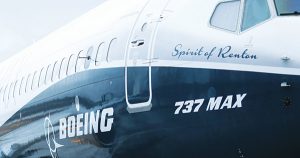Bloomberg
Federal Aviation Administration (FAA) officials have approached US prosecutors to warn them that the lone person charged with a crime after the two fatal crashes of Boeing Co’s 737 Max is being made a “scapegoat,†according to a court filing in the case.
Statements by the Department of Justice after it indicted Mark Forkner, Boeing’s former chief technical pilot, last October contained “many errors in fact,†according to an email and a presentation given to prosecutors by the FAA employees. The case’s focus on Forkner’s actions in the wake of the crashes is “incorrect and misguided,†the FAA officials said.
The unusual assertions by FAA officials, which could substantially undercut the prosecution’s case, were detailed in a motion by Forkner’s lawyers filed in a Texas court asking a judge to order access to the officials as potential witnesses in the case.
One unnamed FAA official approached prosecutors, 12 days after Forkner was indicted, to request a meeting, said the motion by Forkner lawyers Jeff Kearney, Catherine Stanley and David Gerger. “Forkner, he said, is a ‘scapegoat’ and should ‘not be charged,’†the lawyers said in the motion.
In a PowerPoint presentation by FAA officials, with the agency’s logo prominently attached to each page, they say alleged “smoking gun†evidence wasn’t relevant to the case, and Forkner’s role in developing pilot-training for the Max played no role in the FAA’s decision to certify the plane or the design errors that led to the crashes.
The information throws new uncertainty into the Forkner case and the narrative of the 737 Max saga, which prompted a 20-month grounding of Boeing’s best-selling aircraft and led to billions in losses for the planemaker.
It also comprises some of the most detailed explanations about what US regulators believe went wrong in the 737 Max’s approval.
Erin Dooley, a spokeswoman for the US Attorney’s Office in the Northern District of Texas, where the charges against Forkner were filed, declined to comment on the motion.
Crashes off the coast of Indonesia and in Ethiopia within about four months in 2018 and 2019, which killed 346 people, were triggered in part by failures that caused the jets to automatically nosedive repeatedly. In both cases, pilots didn’t perform a procedure that would have disabled the errant system and they eventually lost control of the planes.
Late in the design of the plane, Boeing engineers altered the system to make it push the plane’s nose down more aggressively, but didn’t fully explain the changes to the FAA, according to several investigations.
Boeing struck a $2.5 billion deal in the waning days of the Trump administration that resolved a two-year criminal probe without blaming executives or throttling company finances. The settlement focused narrowly on the actions of Forkner and another former Boeing employee involved in drafting pilot manuals, and
the Justice Department found
that “the misconduct was
neither pervasive across the
organisation, nor undertaken
by a large number of employees, nor facilitated by senior management.â€
The FAA has so far refused to allow any current or former employees to become involved in the case.
 The Gulf Time Newspaper One of the finest business newspapers in the UAE brought to you by our professional writers and editors.
The Gulf Time Newspaper One of the finest business newspapers in the UAE brought to you by our professional writers and editors.
